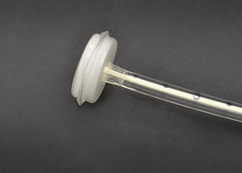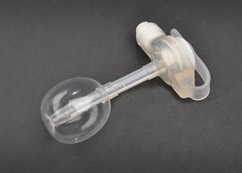In this section
Chapter 1: Introduction
The Tube Feeding Care Notebook
This Care Notebook will help you learn new things. It can be used at home if you need to remember how to care for your child's feeding tube. You can also use it to write down your questions and take notes. Important topics are divided into sections so you can find them easily. You can also find meanings of words that are new to you in our glossary in the back of this notebook.
When do I use the care notebook?
Keep it with you when you are learning in the hospital. Then use it at a home as needed. If you have a concern or question, look in the Care Notebook to decide if you need to call the doctor.
The journey home
The Stepping Stones page is a map. The nurses will check off the stones as you tell or show them that you understand each step. This will help you feel confident when taking care of your child's feeding tube.
To watch helpful videos, visit our video page
A guide for parents
Before your child goes home after getting a feeding tube, you will be able to:
- feed your child through the tube
- give your child any medicines through the tube
- take care of the tube and skin around the tube
- know how to manage some common problems and know who to call for help
Understanding feeding tubes
 What is a gastrostomy tube (G-tube)?
What is a gastrostomy tube (G-tube)?
A gastrostomy tube is a small tube that goes through the skin and muscle into the stomach. It is also called a G-tube. The opening can be called a stoma, site, or tract.
 What is a jejunostomy tube (J-tube)?
What is a jejunostomy tube (J-tube)?
A jejunostomy tube is placed into a part of the small intestine called the jejunum. It is called a J-tube. The jejunum is where food goes when it leaves the stomach.
Why does my child need a feeding tube?
A feeding tube is a safe way to feed your child because it stays in place all the time. It is clamped (closed off) when it is not being used. Some children may be able to eat by mouth and use the feeding tube only when needed. Other children can only be fed through the tube. This all depends on the reason for your child's feeding tube. Your child's doctor will tell you the reasons for a feeding tube.
Some reasons why your child may need a feeding tube:
- Cannot take enough food by mouth to grow and develop
- Has a hard time sucking, swallowing or eating
- Has a problem with reflux, or has a metabolic or breathing problem
Some things that the tube can be used for:
- Giving liquid food
- Giving medicines
- Getting extra air out of the stomach, like a burp. This is called venting
How is the feeding tube put in?
A feeding tube is most often placed in the operating room. Your doctor will tell you how it will be done.
Types of feeding tubes
All feeding tubes have either a balloon or small bumper on the end, which is inside the stomach. This helps keep the tube in place.


Bumper Balloon (filled with water)
Ask your child's nurse for a teaching sheet that explains the type of tube for your child.
Types of G-tubes
Your child will start with one type of tube. The type of tube may be changed later to meet your child's needs.
 Long tubes
Long tubes
This may be needed in the beginning for a short time. Some may have a balloon, while others may have a bumper. It is often replaced with a button type of tube.
Button tubes
This is a short tube that is close to the skin on the belly. It is held in place by a balloon.
Gastrojejunal tubes (GJ-tube)
Some children cannot handle food in their tummy or their stomach has a hard time breaking down the food. They may need to be fed past the stomach into their intestines.
To do this, the tube will be changed from the G-tube to a GJ-tube. This lets you feed into the small intestines. Sometimes, this may be needed for only a short time. Your child's doctor will talk to you if this is needed.
If your child does have a GJ-tube, you will get special instructions on how to use these tubes. See References: GJ-tube Plan of Care.
Questions you may have
How long will it take for the skin to heal?
After surgery, your child will have some pain at the site. The site is most painful for the first couple of days after surgery. The pain gets better each day. Most children are better within 2 weeks.
It is common to have some blood at the site. There will be less blood as the site heals.
The tract is the tunnel from the skin to the stomach. The tract takes about 6 to 12 weeks to heal from the outside of the belly to the inside of the stomach.
While the tract is healing, it is important to care for the skin around the site. In Chapter 2 you will learn how to:
- clean the site
- use a dressing
- keep the tube secure
Once the tract is healed, your child's tube can be changed.
You will not get a spare tube at home until the tube is changed for the first time. After the tube is changed, you will be taught how to change it at home.
Will my child have a feeding tube forever?
This will depend on the reason for your child's feeding tube. It may be needed forever. It may be needed only until your child can eat enough food by mouth to grow.
Who will be a part of my child's care while in the hospital?
- Nurse
- G-tube nurse help care for your child and their feeding tube
- Surgeon or gastroenterologist
- Case Manager – helps arrange for feeding and tube supplies needed for home
- Dietitian – helps with feeding plan for home
Key points
- There are different kinds of feeding tubes
- It is important to take good care of the stoma while it is healing
- You will learn how to care for your child's new tube. It may be scary at first, but you will get really good at it.


